I’ve spent most of my life in Houston. I grew up in its outskirts and attended Rice, where I received my BFA. After that I did some graduate work in Arizona, then returned to complete my MFA in sculpture at the University of Houston. Meaning: I am a product of arguably the top two university art programs in the city, and I know them both from the inside.
The experiences I had at both Rice and UH changed my life. I came into contact with peers and professors who challenged and inspired me. In very different ways, both schools have the potential to ascend to nationally relevant, competitive visual arts programs. After all, Houston is a big city with a dynamic art scene, stacked with depth and diversity. Yet the art programs at both Rice and UH keep stalling out, wading in pools of complacency. Houston is pregnant with possibilities. Why aren’t our universities capitalizing on them?
Rice University
Money
Rice is rich: it has an endowment of $5.5 billion, which places it somewhere in the top 10 university endowments per student. The university has raised tens of millions of dollars for Rice’s Public Art fund and a trendy interdisciplinary center known as the Moody Center for the Arts. But it has prioritized these projects over the needs of an art department that gets perpetually ignored. Meanwhile, there is no MFA program, there’s not even a four-year BFA program, and there are no studios designated exclusively for students. Compared to a much poorer UH that has had all three in place for decades, it is absurd.
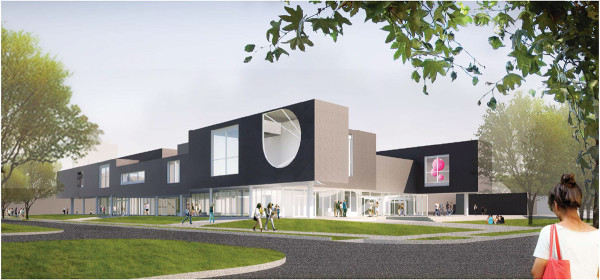
Rendering of the new Moody Center for the Arts at Rice University, scheduled to open Fall 2016. The building will not include studios for student.
Unfortunately, it does not appear likely that the new Moody Center will alleviate any of this: it will not help establish essential degree programs, it will not provide studios for students to call their own; and it barely consulted with the Visual and Dramatic Arts (VADA) faculty during the design phase of the building.* In an additional stroke of insensitivity, Rice demolished an important art landmark in the Art Barn to make room for its construction. This is unconscionable for a school that takes such great pains to preserve its own history, not to mention every single tree on campus. Rice wants a public art program that outshines UH’s percent for art program, and it’s pushing for a Moody Center that rivals similar programs at MIT, Stanford, and UH itself, without implementing the appropriate pedagogical infrastructure to support either.
Faculty
I could never imagine having become an artist without Rice’s faculty. Before I took my first course, the art world might as well have been on Mars—it seemed like a faraway land of the cliché of wine-sipping intellectuals with black turtlenecks and thick-rimmed glasses. But so many professors at Rice were willing to break contemporary art down in a way that was thrilling and unintimidating. Instead of following some rigid academic protocol, the professors gave me the freedom to explore, allowing me the time and space to figure out where my passions lie. Different Core Fellows would (and still do) adjunct every semester, offering fresh perspectives and unique twists on curricula. As much of the elder faculty retire, new professors are coming in, injecting the program with renewed energy and excitement. They seem bent on propelling their art program to new heights, assuming their administration doesn’t fight them every step of the way.
Academic Climate
The college experience at Rice is truly special and unique. I lived on campus all four years and I loved being surrounded by the brilliant, dorky, funny, creative, mischievous, motivated, open-minded people that comprise Rice’s student body. Given that Rice is filled with extremely intelligent, highly self-motivated people, it would seem to be the perfect breeding ground for a top-notch arts program. Unfortunately, its intellectual culture can be very pedestrian, which has led to a student body that largely treats art like a hobby instead of a serious discipline. This culture permeates everywhere, including within the art department.
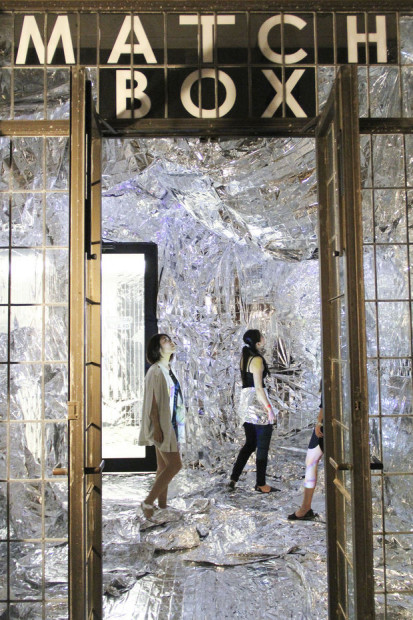
Matchbox Gallery at Rice University [image via the Rice Thresher]
If there is a silver lining to being mired in an oppressive administration that refuses to provide the basic building blocks of a viable arts program, it’s that it forces the department to be more creative, and VADA has begun to respond. With some help from Rice Public Art Fund, it has dug up poky old offices and converted kitchens into small but exciting gallery spaces like Matchbox Gallery and the Emergency Room. Matchbox is a student-run gallery dedicated mostly to exhibiting student work, and the upstairs Emergency Room shows more mature work from local emerging artists and alumni. VADA coordinates their openings with that of Rice Gallery, which is located in the same building. Parking sucks, but the openings are held in the sculpture area’s spacious courtyard, they serve good beer from Valhalla, and almost always have a delicious food truck on hand. Because of this, turnout for these events has snowballed over the years, and it’s generating buzz citywide. Additionally, VADA has just established the Comic Art Teaching and Study Workshop (CATS), which functions partially as a classroom, partially as a small library holding original comic art.
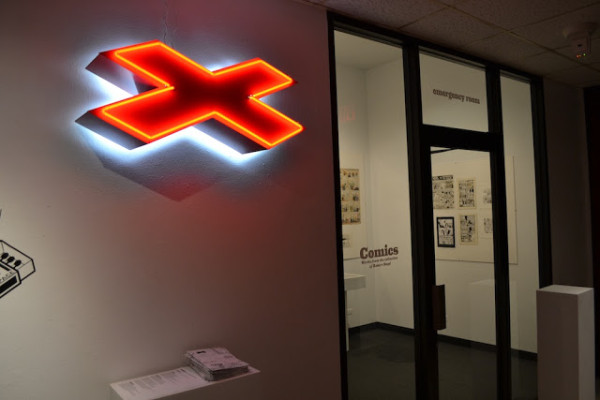
Emergency Room gallery at Rice University [image via The Great God Pan is Dead]
University of Houston
Money
UH’s School of Art doesn’t have much of it. In addition to attending graduate school here, I also attended grad school in Arizona. There were many grad students at my school in Arizona complaining about lack of funding, yet at the time, their teaching stipend was double that of UH’s when I attended, and they provided free medical insurance. The TA stipends at UH increased in my last year there, but it wasn’t of UH’s own accord: it was because the Creative Writing students finally protested. Yes, tuition is lower than most, but as it increases, stipends and scholarships remain paltry. Financial opportunities for students are dwindling and jobs are getting cut. They simply are not competitive, and will have a difficult time recruiting talent until something changes.
Recently, the Joan Wich Foundation donated half a million dollars to the program. That should go a long way towards ameliorating UH School of Art’s financial problems. But the reality is that it is probably going to take more to bolster the Fine Arts program. UH has one of the top entrepreneurship programs in the country. Their students—undergrads no less—raise tens of thousands of dollars flipping burgers on campus in the span of only a week. If the School of Art is not consulting the entrepreneurship department for advice, they should be.
Faculty
UH has a phenomenal, dynamic faculty. There is a healthy sense of differentiation in instruction: while some professors deliver high-intensity, reading-and-production-heavy curricula, others are laid back, allowing students to work at their own pace. This fusion of divergent pedagogical perspectives gives students an underlying structure of pace and self-discipline while also giving them the freedom to explore, challenge authority, and ultimately decide for themselves what matters in their work. There is also a wonderful ethos propagated by faculty of encouraging students to make work they really believe in, to focus on building a life for themselves that is genuine to who they are, as opposed to fretting over “making it” in the art world.
On the other hand, there’s a whole lot of straight white people on the faculty. There’s one black professor, Michael Ray Charles, and he was only hired last year. To my knowledge, there is only one LGBT faculty member. UH has failed to retain talented professors in the past due to a lack of domestic partner benefits; perhaps that will change now that the federal government recognizes the legitimacy of our relationships. But given the homogeneity of the faculty, it’s quite possible that a young artist of color, or a young queer artist, or a young queer artist of color could feel isolated in an environment like this. It certainly does not reflect UH’s student demographic, which is among the most diverse in the country.
Academic Climate
Compared to Rice’s BA, UH has a great setup. The undergraduate block program is a fairly intensive three-semester commitment, providing students their own studios, a real sense of community, and enough critiques so that students have some basis of comparison and competition. On the other hand, there is also a general lack of intensity, because once a student is accepted into the BFA or MFA program, there is little accountability or recourse for substandard work or effort. I remember regularly being impressed by some of the great work being produced by my classmates, but I also remember people being awarded degrees who didn’t deserve them. There’s strong talent coming out of UH each year, but there’s also enough people there who don’t take their education seriously to dampen the discourse and neutralize a healthy sense of competition. Motivated students become isolated not only figuratively but geographically, as the sculpture department is relegated to the far reaches of campus at South Park Annex.
This is where UH could learn from Rice: re-infusing the school with small but powerful implementations like galleries and specialty workshops to spark energy into the program (UH actually led in this area in the early 1980s with the old off-campus Lawndale studio space/laboratory, which was ultimately shut down by the university). True, Rice has more money to do these kinds of things, but as they themselves have shown, a lot can be done with a dumpy old office and a crusty kitchen. UH needs innovation and a way to further connect with the greater Houston art scene, and its insular 4th floor Project Gallery dedicated to the painters is not going to cut it. To UH’s credit, they are trying strengthen the culture: they have pooled financial resources with Rice and the Core Program to bring in stronger visiting artists and critics. However, there were more Rice students than UH students in attendance at a recent Moyra Davey lecture, UH’s own event, which is inexcusable.
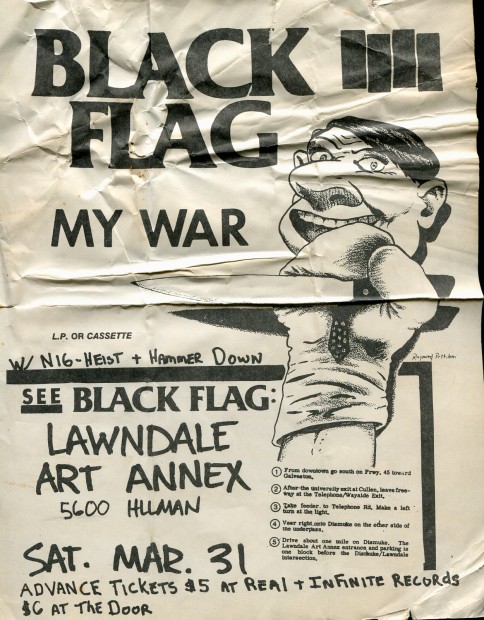
In the good (or bad, depending on your point of view) old days of the original Lawndale–not to be confused with Lawndale Art Center–UH grad students invited bands like Black Flag to perform. UH eventually shut Lawndale down.
Bottom line: someone needs to light a fire under UH School of Art’s asses. Although the university culture is genuinely interested in the work being produced, rather than sheepishly following trends and being obsessed with the art world careerism that is killing more prestigious programs, it can also be provincial. UH needs to step out of its own bubble. Its students should be in dialogue with peers nationally and internationally—UH should be connecting with important residencies and having students compete for a spot in them, and has not capitalized on previous efforts to do so.
Houston’s young artists want to be developed, they want to work hard, and they want to contribute meaningfully to the cultural life of their own city. For all the aforementioned critique, there’s more talent coming out of both Rice and UH than anyone is giving them credit for. A friend recently told me that research universities are not optimal environments for artists. But if a place that offers intense study, community, resources, time, mentors, and like-minded peers is not a proper environment for a young artist, then what is? It ultimately falls to schools like UH and Rice to nurture its city’s raw talent, and given the potential they both truly have, they need to step it up.
* Yes, Rice lumps visual and performing arts into one department.


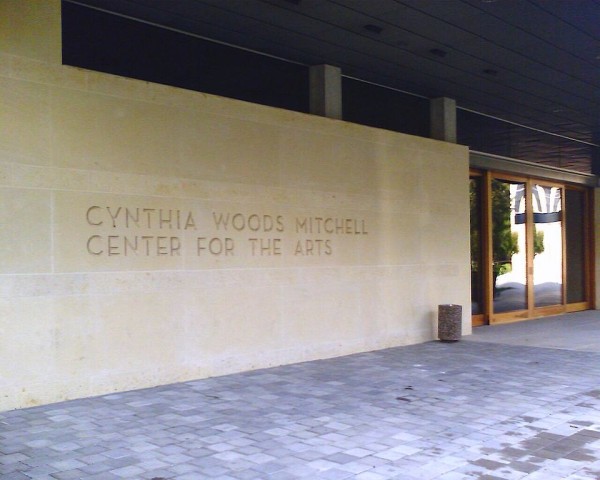
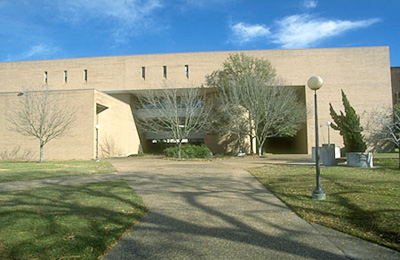

3 comments
zomg clickclickbait, 100 tips to becoming an art star
Clickbait? It doesn’t take long to come up with a list of 100 topics more likely to generate traffic than a comparison of the Rice/UH art departments.
As I Rice grad, I’ve wondered about the status of the undergrad art experience there. I thought the article was very informative. Thanks.
Thank you for your Insider Insights.